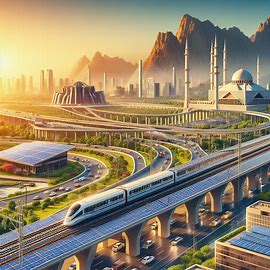
Infrastructure development is crucial for the economic growth and social well-being of any country. For Pakistan, a nation with a rapidly growing population and evolving economic landscape, enhancing infrastructure is both a challenge and an opportunity. This article delves into the current state of infrastructure development in Pakistan, examining the key sectors, challenges faced, and the potential for future growth.
Current State of Infrastructure in Pakistan
1. Transportation
Pakistan’s transportation infrastructure includes roads, railways, ports, and airports. The road network, spanning over 260,000 kilometers, is the backbone of the country’s transportation system. Significant projects like the Motorway Network and the China-Pakistan Economic Corridor (CPEC) have enhanced road connectivity. CPEC, in particular, aims to improve road and rail links between Gwadar Port and China’s Xinjiang region, fostering trade and economic integration.
The railway system, managed by Pakistan Railways, is another vital component. Although it covers over 7,791 kilometers, the network is in dire need of modernization and expansion. Efforts are underway to upgrade the mainline (ML-1) under CPEC, which will increase train speeds and reduce travel time.
Airports in major cities like Karachi, Lahore, and Islamabad have seen improvements, yet regional airports require significant upgrades. Port infrastructure, particularly in Karachi and Gwadar, plays a critical role in international trade, with Gwadar Port poised to become a major hub due to CPEC investments.
2. Energy
Energy infrastructure in Pakistan is characterized by a mix of thermal, hydroelectric, and renewable energy sources. Despite recent improvements, the country faces a chronic energy shortage. Projects like the Neelum-Jhelum Hydropower Plant, Tarbela Dam expansion, and various wind and solar parks aim to bridge the supply-demand gap. The focus on renewable energy has increased, with several wind farms in Sindh and solar projects in Punjab contributing to the national grid.
3. Telecommunications
The telecommunications sector in Pakistan has seen remarkable growth, driven by increasing mobile phone penetration and internet usage. The Pakistan Telecommunication Authority (PTA) regulates this sector, which includes mobile networks, broadband services, and fiber-optic connectivity. The expansion of 4G services and the introduction of 5G technology are set to further enhance connectivity and support digital transformation.
Challenges in Infrastructure Development
1. Financial Constraints
A significant barrier is the insufficient availability of financial resources. Developing large-scale infrastructure projects requires substantial capital, which Pakistan often secures through loans and foreign investments. High levels of public debt and fiscal deficits limit the government’s ability to finance these projects independently.
2. Governance and Corruption
Governance issues and corruption also hamper infrastructure development. Inefficient project management, bureaucratic red tape, and lack of transparency can lead to delays, cost overruns, and substandard construction. Ensuring accountability and transparency is essential for the successful execution of infrastructure projects.
3. Political Instability
Political instability and frequent changes in government policies can disrupt the continuity of infrastructure projects. Long-term planning is often compromised, leading to delays and abandonment of critical projects. Consistent policy frameworks and political stability are crucial for sustainable infrastructure development.
4. Technological and Technical Gaps
Pakistan faces a shortage of skilled labor and advanced technology needed for modern infrastructure projects. This gap often necessitates reliance on foreign expertise and technology, which can be expensive and limit local capacity building. Enhancing technical education and training is vital for addressing this challenge.
Opportunities for Infrastructure Development
1. China-Pakistan Economic Corridor (CPEC)
CPEC is a cornerstone of Pakistan’s infrastructure development strategy. It includes numerous projects aimed at enhancing transportation, energy, and industrial infrastructure. Successful implementation of CPEC projects can significantly boost economic growth, create jobs, and improve regional connectivity.
2. Public-Private Partnerships (PPPs)
Public-Private Partnerships offer a viable solution to the financial constraints faced by the government. By involving private sector investment and expertise, PPPs can enhance efficiency, reduce costs, and accelerate project completion. Successful PPP models in road construction, energy, and water management can be replicated across other sectors.
3. Focus on Renewable Energy
With the global shift towards sustainable development, Pakistan has the opportunity to expand its renewable energy infrastructure. Solar and wind energy projects not only help in reducing the energy deficit but also contribute to environmental sustainability. Incentives for private investments in renewable energy can further stimulate growth in this sector.
4. Urbanization and Smart Cities
Rapid urbanization presents both challenges and opportunities for infrastructure development. The concept of smart cities, integrating digital technology with urban infrastructure, can address issues like traffic congestion, waste management, and public safety. Projects like the Lahore Smart City initiative highlight the potential for creating sustainable and efficient urban environments.
Government Initiatives and Policy Measures
1. National Development Plans
The Government of Pakistan has launched several national development plans aimed at enhancing infrastructure. The Vision 2025 framework outlines strategic goals for infrastructure, including improvements in energy, transportation, and water resources. These plans emphasize the need for sustainable and inclusive development.
2. Special Economic Zones (SEZs)
Special Economic Zones are being developed under CPEC to promote industrial growth and attract foreign investment. SEZs offer tax incentives, infrastructure facilities, and regulatory ease to businesses, fostering economic development and job creation.
3. Regulatory Reforms
Reforming regulatory frameworks to reduce bureaucratic hurdles and improve the ease of doing business is essential. Streamlined approval processes, transparent procurement practices, and robust monitoring mechanisms can enhance project implementation efficiency.
Conclusion
Infrastructure development in Pakistan is pivotal for achieving sustainable economic growth and improving the quality of life for its citizens. Despite facing significant challenges such as financial constraints, governance issues, and political instability, there are ample opportunities for progress. Initiatives like CPEC, public-private partnerships, and a focus on renewable energy can drive substantial improvements in infrastructure. By addressing these challenges through strategic planning, investment in technology, and enhancing governance, Pakistan can unlock its full potential and pave the way for a prosperous future.
Leave a Reply